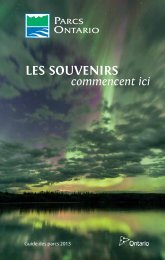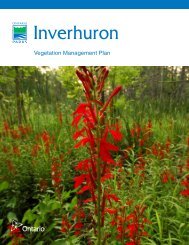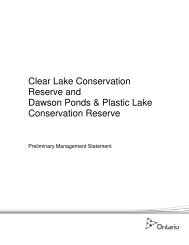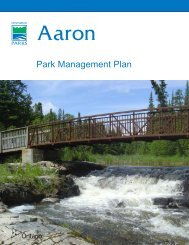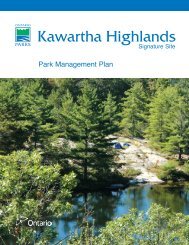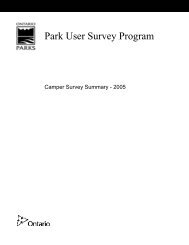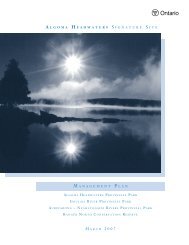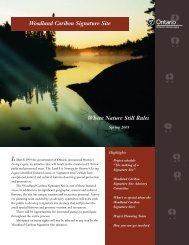Sandbanks Draft Veg Mgmt Plan - Ontario Parks
Sandbanks Draft Veg Mgmt Plan - Ontario Parks
Sandbanks Draft Veg Mgmt Plan - Ontario Parks
You also want an ePaper? Increase the reach of your titles
YUMPU automatically turns print PDFs into web optimized ePapers that Google loves.
IMPLEMENTATION SCHEDULE B – <strong>Plan</strong>tation Renaturalization <strong>Plan</strong><br />
Norway Spruce Stand<br />
The 2 ha stand of Norway Spruce is very dense, with almost no light reaching the forest<br />
floor and therefore no natural infiltration of deciduous species. It does, therefore, provide<br />
winter cover for wildlife. Tree diameters and spacing are quite variable. Diameters range<br />
from approximately 10 – 20 cm, and spacings range from 1 – 2 m. Most trees, while in good<br />
health and very straight, have very small crowns (< 30% of height). These trees may be<br />
marketable, although the area is quite small and will not produce substantial yields.<br />
Restoration and Management Goals<br />
<strong>Plan</strong>tation management for conversion to more natural conditions is a fairly new science,<br />
and it is essential that an adaptive management approach be used. Methods applied in<br />
other plantations may not work at <strong>Sandbanks</strong> due to unique site conditions. Also, due to the<br />
extensive nature of the Scots Pine plantation, it must be accepted that Scots Pine and other<br />
non-native tree species may never be completely eradicated. Therefore, the overarching<br />
goal for management of the plantation at <strong>Sandbanks</strong> is to maintain and enhance<br />
healthy ecological processes. This includes:<br />
• encouraging the establishment and spread of self-sustaining native species<br />
• preventing the loss of soil cover and destabilization of sand<br />
• promoting natural succession<br />
• discouraging the establishment of new invasive species<br />
• ensuring the safety of park visitors and staff<br />
The composition of the forested dunes in the Outlet Sector provides an idea of what the<br />
dunes at West Lake might have looked like before they were logged. However, the<br />
plantation is unique in that the sand substrate recently moved into the area from the West<br />
Lake dunes, and the site was originally similar to the surrounding agricultural and woodlot<br />
area.<br />
Restoration and management of this plantation should be considered successful if the site<br />
eventually supports a diversity of self-sustaining native trees, shrubs, and herbaceous plants<br />
that are able to withstand the harsh environmental conditions of the site. Such a scenario<br />
will undoubtedly include non-native species, but as long as they play a positive ecological<br />
role, they will not detract from the overall goal.<br />
Priorities and Recommendations<br />
Management recommendations have been discussed with forestry specialists and <strong>Ontario</strong><br />
<strong>Parks</strong> staff, and are listed below. Park staff are currently working with fire specialists to<br />
develop recommendations for reducing the fire hazard and promoting restoration of the<br />
plantation.<br />
Monitoring<br />
• Monitoring is an essential component of any restoration project, especially when using<br />
adaptive management. Park staff have noticed marked changes in the plantation in the<br />
past 15 years, and more changes are expect to occur naturally and as management<br />
actions are implemented.<br />
• Areas where restoration is planned should be monitored first to determine species<br />
composition and help determine appropriate restoration goals.<br />
<strong>Sandbanks</strong> <strong>Veg</strong>etation Management <strong>Plan</strong> A-3<br />
<strong>Ontario</strong> <strong>Parks</strong>, SE Zone<br />
2009



